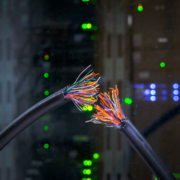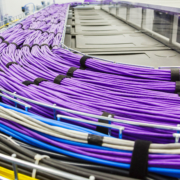What is copper backbone cabling?
Copper backbone cabling are cables which are used in telecommunication industry. These cables are also known as structured cabling or premises cabling because they can be found at all premises which comprises of buildings, warehouses etc. These cables are used for carrying signals between various devices installed at various points inside a building. There are many levels of copper backbone cabling depending upon the speed, distance, and function of data transmission.
Two types of copper backbone cabling systems
1) Unshielded Twisted Pair. (UTP) cable system are used in small buildings or homes where end devices are interconnected with patch panels or wall jacks by using short length UTP cables.
2) Shielded Twisted Pair. (STP) cable system are used in larger buildings or offices where cables run long distances between panels and switches using STP cables.
Types of copper backbone cabling continued
Shielded twisted pair cables provide extra protection against crosstalk, an electrical interference that can cause data loss. Crosstalk occurs when the signal on one cable also affects the signal on an adjacent cable. It can be caused by cables that are too close together or by external factors like electrical equipment. The shielding reduces susceptibility to crosstalk. If you’re running shielded twisted pair, consider using STP connectors to protect wire pairs from EMI / RFI interference.
Copper Cabling Systems
1) 10 Mbps unshielded twisted pair (UTP) system – This system is suitable for small offices and homes. This cable can be easily installed at low costs. These cables do not require extra protection against noise or EMI/RFI interference.
2) 100 Mbps unshielded twisted pair (UTP) system – This system is also suitable for small offices and homes.
3) 1000 Mbps unshielded twisted pair (UTP) systems
– These systems are commonly used in telecommunication industry where large amount of data transfer takes place from one point to another.
4) 10/100 Mbps shielded twisted pair (STP) system
– These systems are also suitable for small offices and homes.
5) 1000 Mbps shielded twisted pair (STP) system
– These systems are commonly used in telecommunication industry where large amount of data transfer takes place from one point to another.
Backbone and horizontal cabling
A backbone cable connects horizontal cables to the different parts of a network. It is also known as backbone cabling, routing cable or vertical cabling.
A front-to-back ratio of between 12 dB and 15 dB is required for most structured cabling installations. This means that the signal strength at the near end is at least 10 times stronger than it is at the far end, allowing for around 3 to 6 decibels of signal degradation due to patch cable connections in the horizontal cable.
Horizontal cabling runs from a central point to individual workstations or telecommunication outlets. It is also known as horizontal cabling, local wiring, side branch wiring or patching cable.
The purpose of the front-to-back ratio of a network is to ensure that the far end signal strength is strong enough for it to be detected and decoded without errors. The strength of the near end signal is typically 20-30 times stronger than that at the far end to account for cable loss and patch cable connections.
Are Cat5e, Cat6, and Cat6a suitable for copper backbone cabling?
All three standards are suitable for copper backbone.
The Type designations refer to the supported transmission speeds; they do not refer to the connection type (i.e., whether it is used in a horizontal or backbone environment). For example, Cat5e supports 10/100 Mbps and Gigabit Ethernet (GbE) only at the physical layer, whereas Cat6 supports 10/100/1000 Mbps at the physical layer.
Cat6a has an additional requirement over Cat6 for sustaining transmission when a 100-meter link operates in full duplex mode, which includes network equipment that supports operation at 10/100/1000 Mbps or GbE speeds. Structured cabling standards such as ANSI/TIA-568-C.2 and ISO 11801 Ed. 2.2 include minimum link performance requirements at each supported data rate, so it is important to ensure that all components of a network architecture are fully tested and listed together for full compatibility.
Is multimode fibre suitable for copper backbone cabling?
Yes. Multimode fibre is suitable for copper backbone cabling.
The bandwidth capabilities of multimode fibre are greater than those of single-mode fibre, which allows it to accommodate 10 Gigabit Ethernet applications over short distances.





